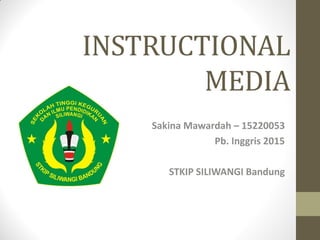
Instructional Media
- 1. INSTRUCTIONAL MEDIA Sakina Mawardah – 15220053 Pb. Inggris 2015 STKIP SILIWANGI Bandung
- 2. Type of Instructional Media As a teacher, we need a media to deliver the material to the students so they can understand better and able to use it in their daily activities. There are many type of media that can be used in Instructional activities. There are: 1. Visual 2. Audio 3. Audio Visual (AV) 4. Computer based 5. Realia These types of media can be chosen after the teacher define the student needs, the material that will be delivered, prerequisite that need to be fulfilled, and many other things that need consideration before that teacher choose the media that they will used for delivering the material to their students.
- 3. Visual Types: 1. Non Projected: cartoon, chart, comic strip, flashcards, illustration, map, models, pictures and poster 2. Projected: filmstrip, overhead projectors,presentatio ns. Role: 1. Attention (to attract and direct the student interest about the material that will be learned through pictures or text about the material. Its used for making it more memorable for the student to memorize about the materials) 2. Affective (picture or visual logo can arouse emotion and student attitude) 3. Cognitive (visual logo or picture can facilitate the delivery of objectives to understand and remember the information or messages contained in images) 4. Compensatory (the visual medium provides a context for understanding the text help students who are weak in reading for organizing information in text and recall) Definition: Visual media is the sources of data or information in the form of visual presentation. There are elements of visual media, there are: line, color, texture, shape, form, value and size. Disadvantage: Negative effect for children behavior, social attitudes and physical health
- 4. Audio Definition: Audio is an electrical or digital representation of sound, that consist of "Aural" (relating sense of hearing) and "Oral" (speaking). Role: • Teach listening • Teach pronunciation and intonation Characteristic: • Clarity of voice • Relevant of topic • Clear pitch • Appropriate length and language • Unbiased content Advantages: • Useful to add, maintain and stimulate interest • Can be use as a set induction strategy • Can clarify problems and ambiguity • Useful in distant learning • Can be use in stimulating emotions • Can aid memory • Helpful in stimulating creative thinking, and increase imagination • Helpful in learning languages Disadvantage: • Assessing or selecting topics • Consume time • Can't learn read • Controlling device is hard • Need more monitoring Type: • Analog: Radio, tapes • Digital: CD, mp3, wav
- 5. Audio Visual (AV) Definition: Conveying information through media, such as audio and visual recordings, that are perceivable by both hearing and sight. Role: • Help provide first concept or impression correct • Encouraging interest • Improve better understanding • Complete other study sources • Adding variety of teaching methods • Save time Characteristic: 1. Audio Visual Media is able to present the information or message in the form of images / visuals and sound in real terms, real. 2. Information submitted may be images / visual facts, real events, or a fiction / creative ideas. 3. Information or messages are packaged in Program Audio Visual techniques can spread through the medium of television, Internet, VCD, DVD. Advantage: • Not boring • Easier to understood the material Disadvantage: 1. The exercise need considerable time. 2. The exercise requires a comprehensive. 3. It costs relatively more expensive. 4. Audio-visual media can not be used anywhere and anytime, because the audio-visual media tend to remain in place.
- 6. Computer Based Definition: Teaching media which student interactive with computer even without an instructor. Role: • Cognitive: Can teach concept of rules, principle, measures, processes, and complex calculations. • Affective: When a program is designed to give a piece of clip sound or video whose contents arouse feelings, learning attitude / affective can be done using computer • Psychomotor: Games and simulation that used to create conditions of the working world. Advantage: 1. Provide opportunities for students to solve problems individually. 2. Provide compelling presentations with animation. 3. Provide learning content choices are many and varied. 4. Capable of motivating students to learn. 5. Capable of activating and stimulating methods of teaching well. Disadvantage: 1. Learners with low motivation or bad study habits may fall behind without the routine structures of a traditional class, students may get lost or confused about course activities and deadlines. 2. Students may feel isolated from the instructor and classmates. 3. Instructor may not always be available for students. 4. Slow Internet connections or older computers may make accessing course materials frustrating.
- 7. Realia Definition: A media that is using real items that found in everyday life as an aid for teaching. Characteristics: 1. Visual message: picture,chart, Diagrams,chart,map. 2. Distributor message visual verbal nonverbal-graphic : book and module, comic, magazine and journals, poster, board visual. 3. Object original and object imitation (model). Advantage: 1. Can foster direct interaction between children with real objects. 2. Can help the children's learning process becomes more active when observing, handling, and manipulating. 3. Media realia can instill basic concepts that are abstract to be true, concrete, and realistic. Disadvantage: 1. The size is there that most of its forms are too large for children and too small so difficult for children to understand the media. 2. The price is expensive media realia. 3. Maintenance realia media must be considered. Role: 1. To attract attention. 2. Clarify the presentation of ideas. 3. Illustrate or decorate a fact that may be quickly forgotten if not visualized.
